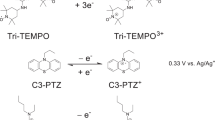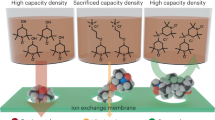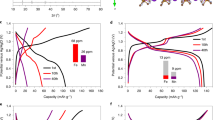Abstract
Operating aqueous redox flow batteries (ARFBs) at low temperatures is prohibited by limited solubility of redox-active materials, freezing electrolytes and sluggish reaction kinetics. Here we report a multi-electron heteropoly acid (H6P2W18O62, HPOM) negolyte that enables high-performance ARFBs at low temperatures. The proton (H+) in HPOM warrants a much higher solubility of polyoxometalates (POMs) (0.74 M at 25 °C and 0.5 M at −20 °C) compared with other cations (Li+/Na+/K+) owing to the strong solvation shell of H+ preventing precipitation. The HPOM also exhibits an exceptionally low freezing point and high conductivity owing to its high solubility and Grotthuss proton-conduction mechanism. These merits warrant HPOM as an ideal POM candidate for high-power-density low-temperature ARFB applications. Using a 0.5 M HPOM electrolyte, the ARFBs demonstrate power density (282.4 mW cm−2) and stability (79.6 Ah l−1negolyte at 160 mA cm−2 over 1,200 h without decay) at −20 °C, showing promising application potential under cold weather conditions.
This is a preview of subscription content, access via your institution
Access options
Access Nature and 54 other Nature Portfolio journals
Get Nature+, our best-value online-access subscription
$29.99 / 30 days
cancel any time
Subscribe to this journal
Receive 12 digital issues and online access to articles
$119.00 per year
only $9.92 per issue
Buy this article
- Purchase on Springer Link
- Instant access to full article PDF
Prices may be subject to local taxes which are calculated during checkout




Similar content being viewed by others
Data availability
The datasets analysed and generated during the current study are included in the paper and its Supplementary Information.
References
Zeyringer, M., Price, J., Fais, B., Li, P.-H. & Sharp, E. Designing low-carbon power systems for Great Britain in 2050 that are robust to the spatiotemporal and inter-annual variability of weather. Nat. Energy 3, 395–403 (2018).
Luo, J., Hu, B., Hu, M., Zhao, Y. & Liu, T. L. Status and prospects of organic redox flow batteries toward sustainable energy storage. ACS Energy Lett. 4, 2220–2240 (2019).
Soloveichik, G. L. Flow batteries: current status and trends. Chem. Rev. 115, 11533–11558 (2015).
Winsberg, J., Hagemann, T., Janoschka, T., Hager, M. D. & Schubert, U. S. Redox-flow batteries: from metals to organic redox-active materials. Angew. Chem. 56, 686–711 (2017).
Wang, K. et al. Broad temperature adaptability of vanadium redox flow battery—part 3: the effects of total vanadium concentration and sulfuric acid concentration. Electrochim. Acta 259, 11–19 (2018).
Liu, Y. et al. Broad temperature adaptability of vanadium redox flow battery—part 4: unraveling wide temperature promotion mechanism of bismuth for V2+/V3+ couple. J. Energy Chem. 27, 1333–1340 (2018).
Xiao, S. et al. Broad temperature adaptability of vanadium redox flow battery—part 1: electrolyte research. Electrochim. Acta 187, 525–534 (2016).
Xi, J. et al. Broad temperature adaptability of vanadium redox flow battery—part 2: cell research. Electrochim. Acta 191, 695–704 (2016).
Mousa, A. & Skyllas-Kazacos, M. Effect of additives on the low-temperature stability of vanadium redox flow battery negative half-cell electrolyte. ChemElectroChem 2, 1742–1751 (2015).
Janoschka, T. et al. An aqueous, polymer-based redox-flow battery using non-corrosive, safe, and low-cost materials. Nature 527, 78–81 (2015).
Li, Z. & Lu, Y.-C. Material design of aqueous redox flow batteries: fundamental challenges and mitigation strategies. Adv. Mater. 32, 2002132 (2020).
Wang, C. et al. Molecular design of fused-ring phenazine derivatives for long-cycling alkaline redox flow batteries. ACS Energy Lett. 5, 411–417 (2020).
Kwabi, D. G., Ji, Y. & Aziz, M. J. Electrolyte lifetime in aqueous organic redox flow batteries: a critical review. Chem. Rev. 120, 6467–6489 (2020).
Goulet, M.-A. et al. Extending the lifetime of organic flow batteries via redox state management. J. Am. Chem. Soc. 141, 8014–8019 (2019).
Li, Z. & Lu, Y.-C. Polysulfide-based redox flow batteries with long life and low levelized cost enabled by charge-reinforced ion-selective membranes. Nat. Energy 6, 517–528 (2021).
Li, Z., Weng, G., Zou, Q., Cong, G. & Lu, Y.-C. A high-energy and low-cost polysulfide/iodide redox flow battery. Nano Energy 30, 283–292 (2016).
Li, B. et al. Ambipolar zinc-polyiodide electrolyte for a high-energy density aqueous redox flow battery. Nat. Commun. 6, 6303 (2015).
Zhang, L. & Yu, G. Hybrid electrolyte engineering enables safe and wide-temperature redox flow batteries. Angew. Chem. 60, 15028–15035 (2021).
Ueda, T. Electrochemistry of polyoxometalates: from fundamental aspects to applications. ChemElectroChem 5, 823–838 (2018).
Wang, S.-S. & Yang, G.-Y. Recent advances in polyoxometalate-catalyzed reactions. Chem. Rev. 115, 4893–4962 (2015).
Li, Q. et al. Polyoxometalate-based materials for advanced electrochemical energy conversion and storage. Chem. Eng. J. 351, 441–461 (2018).
Wang, H. et al. In operando X-ray absorption fine structure studies of polyoxometalate molecular cluster batteries: polyoxometalates as electron sponges. J. Am. Chem. Soc. 134, 4918–4924 (2012).
Jiang, H. et al. A high-rate aqueous proton battery delivering power below −78 °C via an unfrozen phosphoric acid. Adv. Energy Mater. 10, 2000968 (2020).
Yue, F. et al. An ultralow temperature aqueous battery with proton chemistry. Angew. Chem. 60, 13882–13886 (2021).
Feng, T. et al. A redox flow battery with high capacity retention using 12-phosphotungstic acid/iodine mixed solution as electrolytes. J. Power Sources 436, 226831 (2019).
Friedl, J. et al. Asymmetric polyoxometalate electrolytes for advanced redox flow batteries. Energy Environ. Sci. 11, 3010–3018 (2018).
Liu, Y. et al. An aqueous redox flow battery with a tungsten—cobalt heteropolyacid as the electrolyte for both the anode and cathode. Adv. Energy Mater. 7, 1601224 (2017).
Pratt, H. D. III & Anderson, T. M. Mixed addenda polyoxometalate “solutions” for stationary energy storage. Dalton Trans. 42, 15650–15655 (2013).
Pratt, H. D., Pratt, W. R., Fang, X., Hudak, N. S. & Anderson, T. M. Mixed-metal, structural, and substitution effects of polyoxometalates on electrochemical behavior in a redox flow battery. Electrochim. Acta 138, 210–214 (2014).
Chen, J.-J., Symes, M. D. & Cronin, L. Highly reduced and protonated aqueous solutions of [P2W18O62]6− for on-demand hydrogen generation and energy storage. Nat. Chem. 10, 1042–1047 (2018).
Hollas, A. et al. A biomimetic high-capacity phenazine-based anolyte for aqueous organic redox flow batteries. Nat. Energy 3, 508–514 (2018).
Huskinson, B. et al. A metal-free organic–inorganic aqueous flow battery. Nature 505, 195–198 (2014).
Lin, K. et al. Alkaline quinone flow battery. Science 349, 1529–1531 (2015).
Misra, A., Kozma, K., Streb, C. & Nyman, M. Beyond charge balance: counter-cations in polyoxometalate chemistry. Angew. Chem. 59, 596–612 (2020).
Segado, M., Nyman, M. & Bo, C. Aggregation patterns in low- and high-charge anions define opposite solubility trends. J. Phys. Chem. B 123, 10505–10513 (2019).
Zhang, Q. et al. Modulating electrolyte structure for ultralow temperature aqueous zinc batteries. Nat. Commun. 11, 4463 (2020).
Chang, N. et al. An aqueous hybrid electrolyte for low-temperature zinc-based energy storage devices. Energy Environ. Sci. 13, 3527–3535 (2020).
Matsumoto, M., Saito, S. & Ohmine, I. Molecular dynamics simulation of the ice nucleation and growth process leading to water freezing. Nature 416, 409–413 (2002).
Zhang, Q. et al. Chaotropic anion and fast-kinetics cathode enabling low-temperature aqueous Zn batteries. ACS Energy Lett. 6, 2704–2712 (2021).
Brooksby, P. A. & Fawcett, W. R. Infrared (ATR) study of hydrogen bonding in solutions containing water and ethylene carbonate. J. Phys. Chem. A 104, 8307–8314 (2000).
Wolke, C. T. et al. Spectroscopic snapshots of the proton-transfer mechanism in water. Science 354, 1131 (2016).
Wu, X. et al. Diffusion-free Grotthuss topochemistry for high-rate and long-life proton batteries. Nat. Energy 4, 123–130 (2019).
Sadakane, M. & Steckhan, E. Electrochemical properties of polyoxometalates as electrocatalysts. Chem. Rev. 98, 219–238 (1998).
Park, M. et al. A high voltage aqueous zinc–organic hybrid flow battery. Adv. Energy Mater. 9, 1900694 (2019).
Sum, E. & Skyllas-Kazacos, M. A study of the V(II)/V(III) redox couple for redox flow cell applications. J. Power Sources 15, 179–190 (1985).
Liu, T., Wei, X., Nie, Z., Sprenkle, V. & Wang, W. A total organic aqueous redox flow battery employing a low cost and sustainable methyl viologen anolyte and 4-HO-TEMPO catholyte. Adv. Energy Mater. 6, 1501449 (2016).
Prenzler, P. D., Boskovic, C., Bond, A. M. & Wedd, A. G. Coupled electron- and proton-transfer processes in the reduction of α-[P2W18O62]6- and α-[H2W12O40]6- as revealed by simulation of cyclic voltammograms. Anal. Chem. 71, 3650–3656 (1999).
Yao, Y., Lei, J., Shi, Y., Ai, F. & Lu, Y.-C. Assessment methods and performance metrics for redox flow batteries. Nat. Energy 6, 582–588 (2021).
Goulet, M.-A. & Aziz, M. J. Flow battery molecular reactant stability determined by symmetric cell cycling methods. J. Electrochem. Soc. 165, A1466–A1477 (2018).
Jin, S. et al. Near neutral pH redox flow battery with low permeability and long-lifetime phosphonated viologen active species. Adv. Energy Mater. 10, 2000100 (2020).
Kwabi, D. G. et al. Alkaline quinone flow battery with long lifetime at pH 12. Joule 2, 1894–1906 (2018).
Sun, C., Chen, J., Zhang, H., Han, X. & Luo, Q. Investigations on transfer of water and vanadium ions across Nafion membrane in an operating vanadium redox flow battery. J. Power Sources 195, 890–897 (2010).
Feng, R. et al. Reversible ketone hydrogenation and dehydrogenation for aqueous organic redox flow batteries. Science 372, 836–840 (2021).
Jin, S. et al. A water-miscible quinone flow battery with high volumetric capacity and energy density. ACS Energy Lett. 4, 1342–1348 (2019).
Marcus, R. A. On the theory of oxidation‐reduction reactions involving electron transfer. I. J. Chem. Phys. 24, 966–978 (1956).
Huang, B. et al. Cation-dependent interfacial structures and kinetics for outer-sphere electron-transfer reactions. J. Phys. Chem. C. 125, 4397–4411 (2021).
Huang, B. et al. Cation- and pH-dependent hydrogen evolution and oxidation reaction kinetics. JACS Au 1, 1674–1687 (2021).
Marx, D., Tuckerman, M. E., Hutter, J. & Parrinello, M. The nature of the hydrated excess proton in water. Nature 397, 601–604 (1999).
Day, T. J. F., Schmitt, U. W. & Voth, G. A. The mechanism of hydrated proton transport in water. J. Am. Chem. Soc. 122, 12027–12028 (2000).
Filowitz, M., Ho, R. K. C., Klemperer, W. G. & Shum, W. Oxygen-17 nuclear magnetic resonance spectroscopy of polyoxometalates. 1. Sensitivity and resolution. Inorg. Chem. 18, 93–103 (1979).
Mbomekalle, I.-M., Lu, Y. W., Keita, B. & Nadjo, L. Simple, high yield and reagent-saving synthesis of pure α-K6P2W18O62·14H2O. Inorg. Chem. Commun. 7, 86–90 (2004).
Kato, C. et al. Quick and selective synthesis of Li6[α-P2W18O62]·28H2O soluble in various organic solvents. Dalton Trans 42, 11363–11366 (2013).
Chen, J. J. Polyoxometalate Related Redox Flow Batteries (Univ. of Michigan, 2017).
Kozhevnikov, I. V., Sinnema, A., Jansen, R. J. J. & van Bekkum, H. 17O NMR determination of proton sites in solid heteropoly acid H3PW12O40.31P, 29Si and 17O NMR, FT-IR and XRD study of H3PW12O40 and H4SiW12O40 supported on carbon. Catal. Lett. 27, 187–197 (1994).
Herranz, J., Garsuch, A. & Gasteiger, H. A. Using rotating ring disc electrode voltammetry to quantify the superoxide radical stability of aprotic Li–air battery electrolytes. J. Phys. Chem. C. 116, 19084–19094 (2012).
Lu, Y.-C., He, Q. & Gasteiger, H. A. Probing the lithium–sulfur redox reactions: a rotating-ring disk electrode study. J. Phys. Chem. C. 118, 5733–5741 (2014).
Bard, A. J. & Faulkner, L. R. Electrochemical Methods Fundamentals and Applications Vol. 2 (Wiley, 2001).
Xie, J., Liang, Z. & Lu, Y.-C. Molecular crowding electrolytes for high-voltage aqueous batteries. Nat. Mater. 19, 1006–1011 (2020).
Orita, A., Verde, M. G., Sakai, M. & Meng, Y. S. A biomimetic redox flow battery based on flavin mononucleotide. Nat. Commun. 7, 13230 (2016).
Acknowledgements
The work described in this paper was supported by a grant from National Natural Science Foundation of China (51922114, received by Y.-C.L.) and a grant from the Research Grant Council (RGC) of the Hong Kong Special Administrative Region, China (project number T23-601/17-R, received by Y.-C.L.).
Author information
Authors and Affiliations
Contributions
F.A. and Y.-C.L. conceived the project, analysed the data and wrote the manuscript. Z.W. designed the flow battery cell. F.A. and Q.Z. conducted RRDE and UV–visible measurements. F. A. and Z.L. conducted OEMS measurements. F. A. and N.-C.L. conducted HPOM synthesis.
Corresponding author
Ethics declarations
Competing interests
F.A. and Y.-C.L. are inventors with a patent application (US application number 17/681,016) on the flow battery electrolytes described herein. Z.W., Q.Z., Z.L. and N.-C.L. declare no competing interests.
Peer review
Peer review information
Nature Energy thanks Travis Anderson and the other, anonymous, reviewer(s) for their contribution to the peer review of this work.
Additional information
Publisher’s note Springer Nature remains neutral with regard to jurisdictional claims in published maps and institutional affiliations.
Supplementary information
Supplementary Information
Supplementary Figs. 1–32, Tables 1–5 and Note 1.
Rights and permissions
About this article
Cite this article
Ai, F., Wang, Z., Lai, NC. et al. Heteropoly acid negolytes for high-power-density aqueous redox flow batteries at low temperatures. Nat Energy 7, 417–426 (2022). https://doi.org/10.1038/s41560-022-01011-y
Received:
Accepted:
Published:
Issue Date:
DOI: https://doi.org/10.1038/s41560-022-01011-y
This article is cited by
-
Recent Advances in Redox Flow Batteries Employing Metal Coordination Complexes as Redox-Active Species
Electrochemical Energy Reviews (2024)
-
An active and durable molecular catalyst for aqueous polysulfide-based redox flow batteries
Nature Energy (2023)
-
Boosting the energy density of sulfide-based all-solid-state batteries at low temperatures by charging to high voltages up to 6 V
Nano Research (2023)
-
Working in the cold
Nature Energy (2022)
-
Designing modern aqueous batteries
Nature Reviews Materials (2022)



